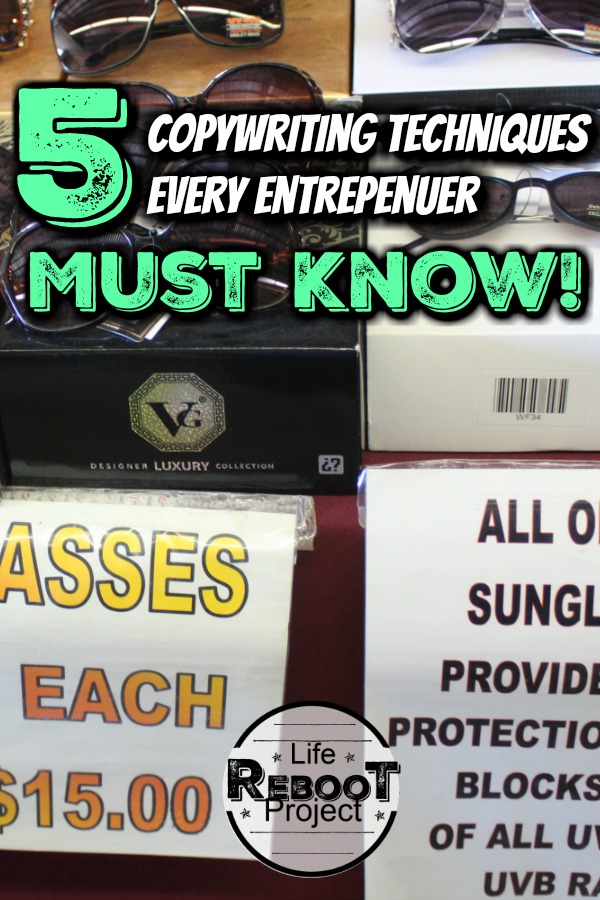
Copywriting is the most powerful skill to have in your solopreneur adventure. The good thing is, to get by, you don’t need to be a world-class copywriter to see some excellent results. There are only a handful of skills to master to be good enough to make a difference in your campaign.
There are only a handful of skills to master to be good enough to make a difference in your campaign. I studied copywriting for a while. I took some courses and read some books. I do some freelance work now for some agencies. What I’ve found is there is something like an 80/20 principle going on with copywriting.
I’ve boiled them down to my ‘Fabulous 5’ things to incorporate into your writing to make it copywriting-worthy. I’m continually changing up my approach, but the ‘Fabulous 5’ are the ones I work on the most.
Copywriting Tips #1 | Make sure your headlines grab the reader.
I’m continually working on my headlines. When I first started writing my new blog, I went for shock appeal. I tried doing headlines like I would if I were writing to the general public. I tried to weave in outrageous juxtapositions and those factors that would make people snap their necks in reaction.
Lately, though, I’ve softened a bit and went for a more informational and subtle approach. I tried to lure people in for the purely informational content I was providing. Now, I’m going to go back and change some of my headlines for some more shock appeal as I keep searching for the best conversion.
Juxtapositions are those attention-grabbing bits that leave the reader to say, ‘Is that even possible?’ Of course, you can’t do this in a click-bait way. You will need to make good on the headline, so you don’t lose trust with your reader. John Calton does this perfectly with his ‘One-Legged Golfer Headline.’
The last thing that comes to mind is the fact that a one-legged golfer could be that good. It makes you dig into that article to find out how that is even possible. The job of the headline is to pull the reader into the article and get them to read the first line.
Copywriting Tips #2 | Weave a compelling story into your ads.
Stories are becoming more popular in mainstream marketing and advertising, but they have been used for years in direct response. I’m no psychologist, but I guess we are wired to respond well to stories.
As the direct response copywriting genre and the traditional copywriting and advertising continue to melt together, the one thing the conventional side is taking from the direct response side is their use of storytelling when writing ads. Even television commercials are strung together multiple commercials to tell one story. They are also using the old ‘cliffhanger’ technique made famous in soap operas.
Before every commercial break or end of the day’s episode, they insert a little question in the viewer’s mind as to what will happen next. These questions keep the watcher tuning in to find out what happens next. In the online world, a guy named Andre Chaperone uses this technique masterfully to create a series of emails linked together with one common story and cliffhangers to keep the readers coming back for more every time.
As I track what is going on in the marketing and advertising world, I see more and more people weaving stories into their copy to build their brand and pull readers back to them for more. Stories are a powerful tool to master.
Copywriting Tips #3 | Make sure you have a compelling ‘call to action’.
If you want to get people to do something, you will need to ask them to do it. A ‘Call to action’ is another fundamental principle that you need to add to any piece of copy. Too many people are afraid to ask for action. It gets muddled somewhere near the end and is often just implied that you want to have something happen.
This needs to be blunt and very specific. If you want someone to sign up for your email list, you will need to ask them. Same with making the sale. If you’ve presented your case well why the product you are offering to them will help them solve a problem, don’t be afraid to ask for the sale.
Some of the problems may stem from the fact that you are not convinced that what you are selling them will help them. I’d say you need to clarify this in your mind first. You need to first, convince yourself that it is a worthwhile product before you can convince anyone else that this is a useful product.
Once you know that what you are offering is what people need, and you want to help other people, you can’t be afraid to ask for a sale.
Copywriting Tips #4 | Give them enough not to feel cheated, but always tease to more.
You will always want to satisfy what you promised the reader in your headline, but after that, it’s ok to imply that you have much more for them if they keep reading what you send them or sign up for a list, or take an action you want them to make.
This has the same powerful effect as the cliffhanger I was talking about above. You need to make your content strong enough for the reader to think, “If this free stuff was great, what else could I get if I dig just a little deeper”?
This is what you want. This is why many marketers today suggest giving away all your best advice for free. I’m not entirely in line with this mentality. I still believe that you sell your best stuff. I’d hate for someone to buy something from me only to experience a letdown that didn’t live up to the hype.
Copywriting Tips #5 | Make your offer irresistible.
Making your offer irresistible is another thing I learned from John Carlton. People use all sorts of techniques for this from making an irresistible money-back guarantee to setting the idea in the reader’s mind that without a doubt, they cannot lose. Carlton uses a ‘knock them off the fence’ analogy.
By the time they get done looking at your article or ad, the reader is sitting on the fence and could go either way toward responding to the offer. Finishing off the offer to make it irresistible, is the last thing you need to do. This is your last-ditch effort at sprucing up the offer to ‘knock them off the fence’.
You need to instill in your reader’s mind that there is no downside only upsides. Often strictly listing the benefits is strictly not enough. You probably will need to offer them a way out if all doesn’t go that well.
Copywriting Tips #6 | Use testimonials either implied through the story or actual testimonials.
Ok, one more. Testimonials are too compelling not to use. These are as good as old-fashioned word-of-mouth advertising. Most people are always on the alert for being scammed whenever they are looking at a purchase. It’s like some battle is ensuing between buyer and seller. The seller will always have their defenses up, ready to be utterly analytical about any part of the sale.
Testimonials help to bring down a buyer’s defenses by saying, “Someone just like you loves this product and has had great success with it”. You won’t need to be a copywriting guru to see some pretty decent results; you need to concentrate your efforts on experimenting and honing the craft in just a couple of small areas.
80 percent of the success you will have will come from a mere 20 percent of the sales techniques employed in your copy. The ideas listed above will also prove useful even if you aren’t putting together a sales pitch for a product. Use these techniques in everything from blog posts to about pages used to build your brand. Use these techniques even if you are selling things in ads on Craigslist, Amazon, or eBay.
As you get better, you’ll find yourself infusing small pieces of all these copy techniques into everything you write. All of this builds on my strategy to help you get out of your 9 to 5 job and create a life where you make all the decisions.
You will decide how much vacation time you deserve. You will decide if you are good enough for a raise. You will decide whether it’s ok to start at eight in the morning or eight-fifteen.
Til next time,
Kevin

